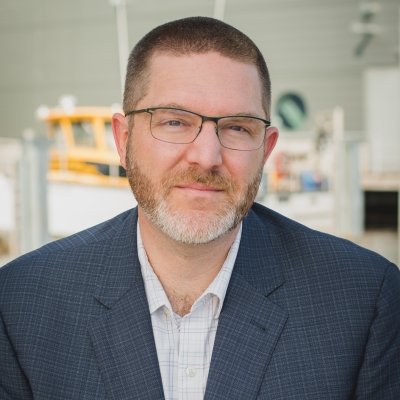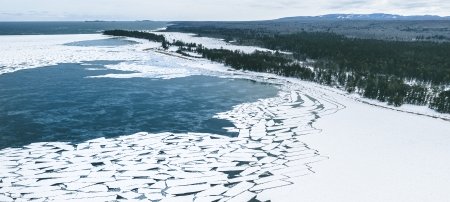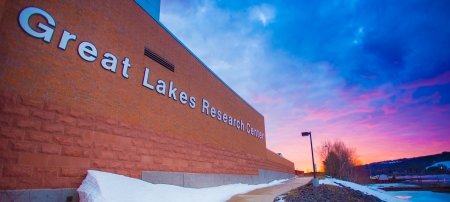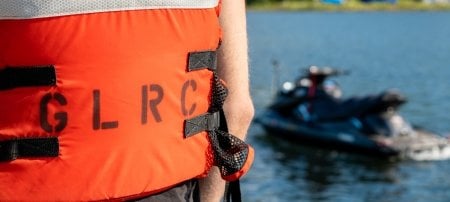Andrew Barnard is the new director of the Great Lakes Research Center.
Andrew Barnard came to Michigan Technological University as an acoustics researcher. Since July 1, he’s now the director of the Great Lakes Research Center, associate professor of mechanical engineering-engineering mechanics and faculty advisor to the SENSE Enterprise program.
Barnard is also the recipient of Michigan Technological University’s 2019 Distinguished Teaching Award in the Assistant Professor/Lecturer/Professor of Practice category. His research in acoustics and noise control tailors well with the mission of the Great Lakes Research Center, which seeks to educate the scientists, engineers, technologists, policymakers and stakeholders of tomorrow about the Great Lakes basin.
Barnard succeeds Guy Meadows who is now the director of the marine engineering laboratory and the Robbins professor of sustainable marine engineering.
Recently we sat down with Barnard to discuss the future of the Great Lakes Research Center (GLRC) and his role at Michigan Tech.
"We have multidisciplinary researchers, and we have an extremely large testbed that’s vastly underused — Lake Superior. It’s a great opportunity."

Q: Why were you selected as the next GLRC director?
A: The GLRC is a soft-money research institute (“soft money” means the center’s funding is obtained through research grants and not tuition), so it operates a bit differently than an academic department on campus. Before I came to Michigan Tech I worked for the Applied Research Lab at Penn State (also soft money-funded). I have the perspective of working at a soft money-funded institute and being a soft money-funded researcher. I’m also a newly tenured faculty member. It’s good to have both of those perspectives.
The GLRC is something of a grand experiment: multi-disciplinary, faculty-driven research on really cool water-focused projects using a soft-funding mentality.
What do you do in your work?
I do acoustics in general. What I’m interested in is making mechanical things quiet. I tend to work on any type of system with rotating equipment: ship propellers, hard drives, hydraulic systems. That is to say, anything moving that creates sound or is affected by sound.
It’s a very customer-centered research field because everyone has a set of transducers built into their heads — ears. We have lots of customers to talk to and lots of customer problems to fix because certain sounds drive people nuts.
We have the same problems under water. The overall background noise in the ocean has been rising steadily since WWII. How does that affect marine mammals and fish species? How does their behavior change based on ambient noise background?
You frequently work with the U.S. military. What’s important about acoustics to the military?
On the military side it’s all about stealth and tactics. How do I prevent myself from being detected and how do I detect the other guy?
With Tim Havens, William and Gloria Jackson associate professor of computer systems and director of the Institute for Computing and Cybersystems, I am working on detection of on-ice sources from underwater in the Arctic. As the Arctic opens up to more tourism, oil exploration and commercial transit, there is more activity on top of the ice — people are boring holes, there are snowmobiles and other anthropogenic noise sources. If we establish listening stations underwater we can classify what’s going on, localize where it is and track it. But we are developing machine learning algorithms to improve on traditional techniques.
How does your work relate to the other research at the GLRC?
Acoustics is ubiquitous in the underwater environment because forms of data communication under water are extremely limited. There’s no GPS or radio. The thing that travels well through water is sound. We use sound for detection, for sonar, for bathymetry to map the bottom.
If it’s any sort of multidisciplinary team working in an underwater environment, there’s almost always an acoustic piece to it.
Because of my background working with the U.S. Navy I bring a lot of relationships to the table. I’m excited to do more work in that area and expand the GLRC’s offering to different funding sources.
What are the challenges facing the GLRC?
I’d like to see us have more of a common vision as to where the center itself is headed. Instead of having a disparate bunch of people working together, have a common purpose and mission. As we grow we can provide more scientific and technical person-power to help faculty and researchers deliver on their projects so they can focus on the marketing and proposal parts of the process.
We are somewhere very remote. But that gives us the opportunity to tout our Arctic-like environment for on-ice research because this is one of the few places that has sustained ice for a long enough field session in a deep enough water body. One of the biggest points of failure for Arctic research missions is that researchers aren’t prepared and things fail. It’s much more inexpensive and efficient to do pre-testing here in Houghton, so when they do travel to the Arctic they are assured success.
What is your vision for the future of the GLRC?
I want to see the center grow. I would love to see it grow through organic collaboration through multidisciplinary teams. I want to see us go after projects that have effects in the Great Lakes and beyond, by working with people in different colleges who normally wouldn’t work together. Big problems that require lots of different expertise and teamwork. I am a strong proponent of a diversified research portfolio that we market well.
Michigan Technological University is an R1 public research university founded in 1885 in Houghton, and is home to nearly 7,500 students from more than 60 countries around the world. Consistently ranked among the best universities in the country for return on investment, Michigan's flagship technological university offers more than 185 undergraduate and graduate degree programs in science and technology, engineering, computing, forestry, business, health professions, humanities, mathematics, social sciences, and the arts. The rural campus is situated just miles from Lake Superior in Michigan's Upper Peninsula, offering year-round opportunities for outdoor adventure.







Comments